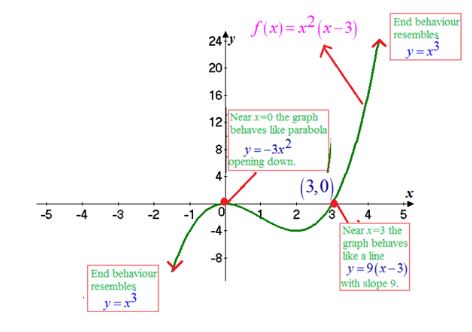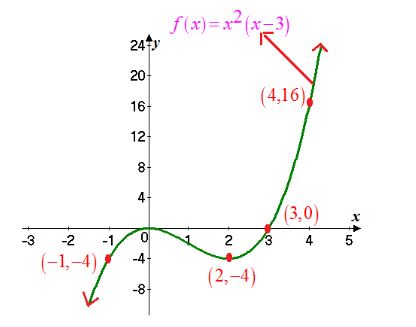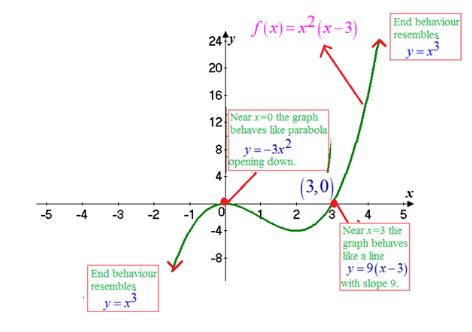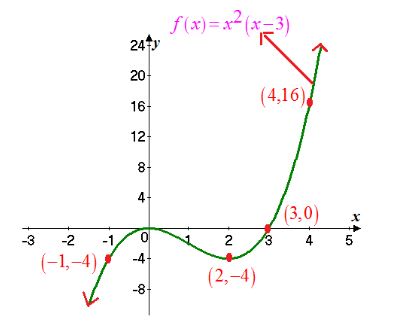
Concept explainers
To analyze: the given polynomial function
Answer to Problem 69AYU


Explanation of Solution
Given:
Formula Used:
Calculation:
Consider the following polynomial:
The objective is to analyze each polynomial function using the analyzing the graph of a polynomial function.
Step1: To determine the end behavior of the graph of the function.
The graph of a polynomial function is.
Expand the given polynomial and its write to the above form.
The polynomial function has degree
Step2: Find
The
So, the
The
So, the
Steps3:
To determine the zeros of the function and their multiplicity using this information whether the graph crosses or touches the
The graph of
The zeros of the function
The intercept
So, the graph of
The intercept
So, the graph of
Step4:
To determine the maximum number of points on the graph of the function use the result.
The maximum number of turning points is,
Here, the degree of the given polynomial function is
So, the maximum number of turning points is
Hence, the graph of
Steps5:
To determine the behavior of the graph of
The two
The graph of
So, the behavior of the graph of
The graph of
So, the behavior of the graph of
Step6: Use all the above information from step 1 to step 5 to draw a complete graph of the function.
First figure illustrates that the information obtained from step 1 to step 5. Notice that to evaluate that
Draw the following figure1:

The graphs of the given polynomial function

Conclusion:
Thus, the graph of
Chapter 4 Solutions
Precalculus
Additional Math Textbook Solutions
Pre-Algebra Student Edition
Elementary Statistics: Picturing the World (7th Edition)
Basic Business Statistics, Student Value Edition
Thinking Mathematically (6th Edition)
Algebra and Trigonometry (6th Edition)
- Let the region R be the area enclosed by the function f(x)= = 3x² and g(x) = 4x. If the region R is the base of a solid such that each cross section perpendicular to the x-axis is an isosceles right triangle with a leg in the region R, find the volume of the solid. You may use a calculator and round to the nearest thousandth. y 11 10 9 00 8 7 9 5 4 3 2 1 -1 -1 x 1 2arrow_forwardLet the region R be the area enclosed by the function f(x) = ex — 1, the horizontal line y = -4 and the vertical lines x = 0 and x = 3. Find the volume of the solid generated when the region R is revolved about the line y = -4. You may use a calculator and round to the nearest thousandth. 20 15 10 5 y I I I | I + -1.5 -1 -0.5 0.5 1 1.5 2 2.5 3 -5 I -10 -15 I + I I T I I + -20 I + -25 I I I -30 I 3.5 4 xarrow_forwardplease show all the workarrow_forward
 Calculus: Early TranscendentalsCalculusISBN:9781285741550Author:James StewartPublisher:Cengage Learning
Calculus: Early TranscendentalsCalculusISBN:9781285741550Author:James StewartPublisher:Cengage Learning Thomas' Calculus (14th Edition)CalculusISBN:9780134438986Author:Joel R. Hass, Christopher E. Heil, Maurice D. WeirPublisher:PEARSON
Thomas' Calculus (14th Edition)CalculusISBN:9780134438986Author:Joel R. Hass, Christopher E. Heil, Maurice D. WeirPublisher:PEARSON Calculus: Early Transcendentals (3rd Edition)CalculusISBN:9780134763644Author:William L. Briggs, Lyle Cochran, Bernard Gillett, Eric SchulzPublisher:PEARSON
Calculus: Early Transcendentals (3rd Edition)CalculusISBN:9780134763644Author:William L. Briggs, Lyle Cochran, Bernard Gillett, Eric SchulzPublisher:PEARSON Calculus: Early TranscendentalsCalculusISBN:9781319050740Author:Jon Rogawski, Colin Adams, Robert FranzosaPublisher:W. H. Freeman
Calculus: Early TranscendentalsCalculusISBN:9781319050740Author:Jon Rogawski, Colin Adams, Robert FranzosaPublisher:W. H. Freeman
 Calculus: Early Transcendental FunctionsCalculusISBN:9781337552516Author:Ron Larson, Bruce H. EdwardsPublisher:Cengage Learning
Calculus: Early Transcendental FunctionsCalculusISBN:9781337552516Author:Ron Larson, Bruce H. EdwardsPublisher:Cengage Learning





